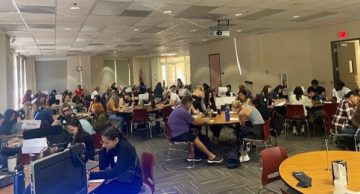INTERNATIONALIZATION. This autumn Sepideh Olausson, an associate professor in health sciences, is at Arizona State University in Phoenix, Arizona. There she works at Edson College of Nursing and Health Innovations on a teaching sabbatical funded by the Swedish Foundation for International Cooperation in Research and Higher Education (STINT). Olausson says she finds inspiration in teaching and academic leadership.
STINT’s Teaching Sabbatical program aims to develop both individuals and institutions. By giving researchers and teachers who are passionate about education international experiences relevant to their teaching role, rather than their role in research, STINT wants to contribute to educational renewal and creating new networks.
Varied approach with small cultural clashes
“The weeks seem a little different here,” Olausson says. “Sometimes I have several teaching sessions during a week and sometimes I spend the weeks engaging in various meetings, research activities, and field trips. My assignments here vary, and I have been allowed great freedom to design how I spend my time. It is great fun and stimulating to be a part of this large, dynamic, and vibrant workplace, so I really enjoy it!
I have experienced some cultural clashes,” she says with a chuckle, “but nothing worse than thinking I am going to meet for coffee or have dinner with someone, not realizing this was a casual comment and not a real invitation. I have found it a bit difficult to understand whether people really mean what they say, based on my Swedish understanding of culture.
Once I was invited to a birthday party at the head of department along with a few others. She had prepared food, cake, and drinks, and we talked about our best memories of previous birthdays. It strengthens a sense of belonging with the group.”
Investing in retaining students

“Another thing I have been thinking about is the enormous support that exists in the education and the careful follow-up of student results. This occurs regularly, which helps the university to keep them enrolled in courses. The American education system is complex, but at the same time it allows students great freedom in composing their own education. Arizona State University is gigantic and at the forefront of innovation and interaction with the nearby community, especially the municipality and care providers.
Some aspects are better, but there are also things that do not measure up to what we have at home at the University of Gothenburg. A clear example is our work with health and a sustainable work environment at the University. I think we are light years ahead of the United States, even though Arizona has adapted the concept of ‘Wellness’ in terms of everyday exercise, fitness, and health. They work with this both in the courses for students and for staff (wellness breaks).”
More administrative support
“Another difference is program administration. Many courses have a teaching assistant, who can be a master’s student or doctoral student being introduced to teaching. Each program director also has dedicated administrative support. This means that the teachers teach a lot but also have time to do so because they have less administration. Each research team also has a person responsible for research administration, such as writing ethics applications, entering data, or recruiting informants. The email and meeting culture is also different from what I am used to. Communication takes longer, but the meetings are more controlled and shorter.

The terms of employment are very different than at the University of Gothenburg. Many teachers have temporary employment, and sometimes teachers only have freestanding courses. This allows greater flexibility. The system provides many support units and resources for inexperienced teachers. Academic freedom is another thing I have observed. As a teacher in the course, you have great authority and freedom to design the course. Contact between teachers and students is another difference, in my view. You have very close contact with students, and the students I have are very motivated to complete their education.
I feel really privileged to be here and have this opportunity to learn so many new things. What has been a bit daunting at the beginning of the stay was the heat. It was 40–44 °C. (104–111 °F) for a month, day and night. It is frightening what impact such a hot climate has on our lives and on nature.
There are a lot of things that I would like to discuss and tell my colleagues. I have received a lot of inspiration both in terms of teaching but also academic leadership. There are things we could make use of. Fortunately, I have also made some really good contacts for future research and exchanges.”
BY: LOVISA AIJMER











